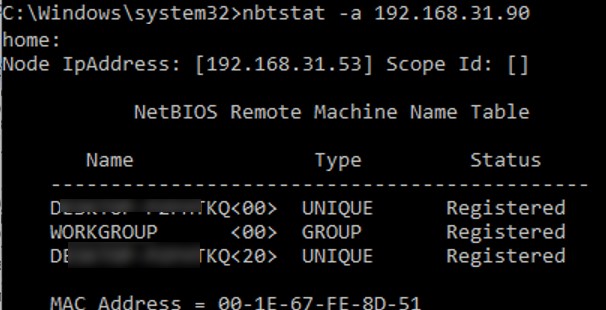

5298/tcp Disable ports on Ubuntu To reverse the changes you have previously made.
#Disable netbios over tcp code
Option MSFT.release-lease-on-shutdown code 2 = unsigned integer 32 Allows you to share your printer with other people over the network.
#Disable netbios over tcp windows
In Windows NT it ran on top of NetBT (NetBIOS over TCP/IP, ports 137, 139 and 138/udp). Option MSFT.disable-netbios code 1 = unsigned integer 32 You can use various means to disable SMB v1 in your network. You can omit the ‘MSFT.release-lease-on-shutdown’ line just for disabling NetBIOS over TCP/IP, but I write it here as it may be useful as described later. Run the first command again to confirm the NetBIOS status of each network adapter.You may already know it, but I introduce in this post the way to disable NetBIOS over TCP/IP (NetBT) on Windows hosts whose IP addresses are dynamically allocated using the ISC DHCP server.įirst, the following settings must be added to nf. A ReturnValue value of 0 indicates that the operation was successful. Remove the -Confirm parameter to simply disable NetBIOS for all of the previously shown network adapters and thereby make the process faster.Ī list of ReturnValue values should be shown. The -Confirm parameter requires confirmation for each change, which is helpful if one has multiple network adapters and only wants to change the NetBIOS status for some of them. Invoke-CimMethod -Query $query -Namespace Root/CIMV2 -MethodName SetTcpipNetbios -Arguments $arguments |Īdd-Member -MemberType ScriptProperty -Name ReturnValueFriendly -Passthru -Value -Confirm $query = 'Select * From Win32_NetworkAdapterConfiguration Where (ADD FILTER CLAUSE HERE!)' # if you want to apply the method to ALL instances, remove "Where." clause altogether.

# you can use "Get-CimInstance -Query (ADD FILTER CLAUSE HERE!)" to safely play with filter clauses # select the instance(s) for which you want to invoke the method $arguments = (12345) # replace 12345 with a meaningful value # see section "Parameters" below for a description of each argument. # make sure you replace values with meaningful content before running the code # remove values that you do not want to submit

You should definitely test this first and understand the ramifications.Īs WMI v1 cmdlets were removed in PowerShell 6, the "modern way" to do this is through CIM cmdlets, with an example from powershell.one: # define the arguments you want to submit to the method Make sure to check the list here, and do not lazily assume that the function will work on every device. There are a number of possible return codes though, like a WHOLE lot. $adapter.SetTcpIPNetbios(0) | Select ReturnValue $adapter = Get-WmiObject Win32_NetworkAdapterConfiguration | Where Description -like "*Ethernet*" Select the one you want to disable using a filter provided to Where Object, like this. When used the Author and URL above must remain in place, unaltered.
#Disable netbios over tcp free
The following features were tested in ePO 5.9.x and 5.10.0, after NetBIOS over TCP/IP was disabled using the steps described in this article. ' 1 - Enable NetBIOS over TCP/IP ' 2 - Disable NetBIOS over TCP/IP ' 'License: This script is free to use given the following restrictions are followed. ServiceName DHCPEnabled Index Description NOTE: If any settings other than the ones listed above are changed, this support statement does not apply. You might wish to be more discerning, and be sure you're disabling Netbios on the right interface, however, so I would first run Get-WmiObject Win32_NetworkAdapterConfiguration | Where IPAddress, to see a list of your adapters which are currently connected. According to Andre Viot's blog: $adapters=(gwmi win32_networkadapterconfiguration )


 0 kommentar(er)
0 kommentar(er)
